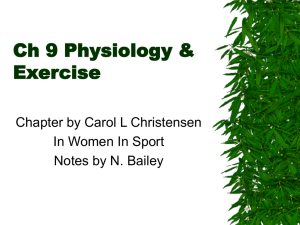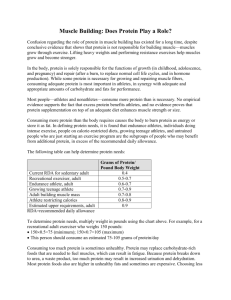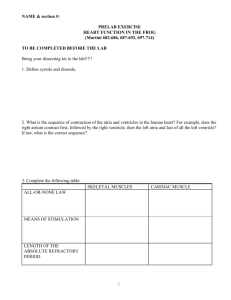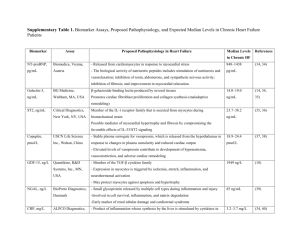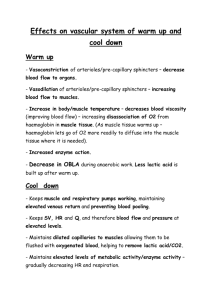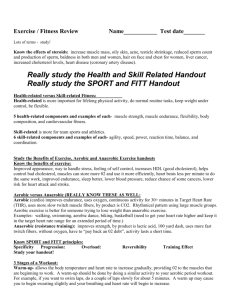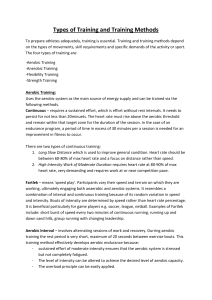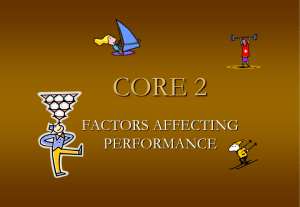Exercise/Sports Physiology
advertisement
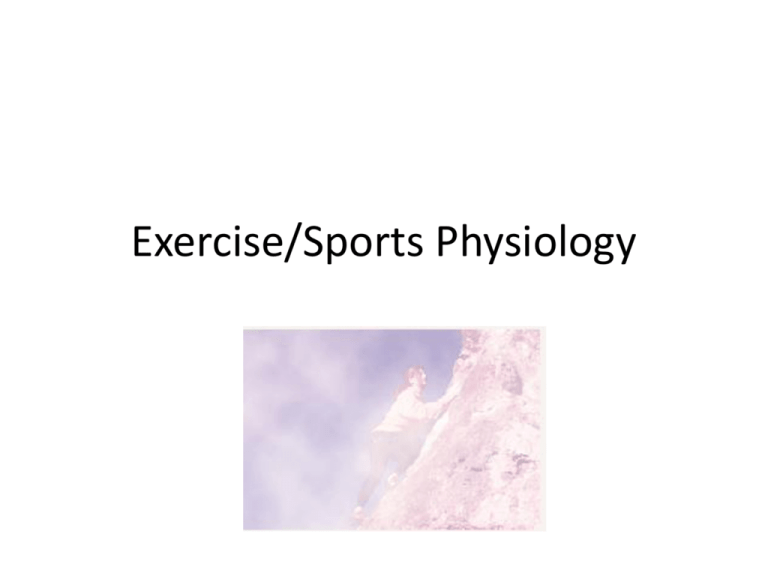
Exercise/Sports Physiology Learning Objectives • Definitionsi. Aerobic vs. anaerobic ii. Isometric vs. Isotonic iii. Acute response vs. exercise training • Sk muscleATP synthesis pathway Aerobic exercise training Anaerobic exercise training • Motor and Autonomic control • CVS- B.P; HR; CO; VR; Flow redistribution; training. • RS- Ventillation; Oxygen extraction; EPOC; Training Exercise Classification Energy System Time Course 1. Adenosine triphosphate– creatine phosphate system;phosphagen sys : 8 – 10 s 2. Glycogen Lactic acid system: 0.5- 2.5 min 3. Oxidative phosphorylation: hrs Which of the following sources can produce the greatest amount of ATP per minute over a short period of time? A) Aerobic system B) Phosphagen system C) Glycogen-lactic acid system D) Phosphocreatine system E) Stored ATP Which of the following athletes is able to exercise the longest before exhaustion occurs? A) One on a high-fat diet B) One on a high-carbohydrate diet C) One on a mixed carbohydrate–fat diet D) One on a high-protein diet E) One on a mixed protein–fat diet Most of the energy for strenuous exercise that lasts for more than 5 to 10 seconds but less than 1 to 2 minutes comes from which of the following sources? A) Adenosine triphosphate (ATP) B) Anaerobic glycolysis C) Oxidation of carbohydrates D) Oxidation of lactic acid E) Conversion of lactic acid into pyruvic acid Effect of diet on the rate of muscle glycogen replenishment after prolonged exercise. Effect of duration of exercise as well as type of diet on relative percentages of carbohydrate or fat used for energy by muscles: Aerobic exercise training Anaerobic exercise training 1. Energy stores: increase in myocyte gly-cogen stores. 2. Metabolism: increases mitochondrial size and numbers and increase in myoglobin content 1. Hypertrophy: increase in the cross-sectional area of type IIa and IIx muscle fibers by adding new myofibrils to the myocytes. 2.Neural recruitment: 3. Metabolism and energy stores: Effects of training on muscle mass and performance. MOTOR AND AUTONOMIC CONTROL Peripheral Nervous System • Alpha-Motor neurons: • Motor units: • Muscle sensors: Mus spindle, Golgi tendon organs, Mus afferents • Cardiovascular receptors Central nervous system 1. Somatic: The premotor cortex, supplemental motor cortex, and basal ganglia aid in motor program development. This motor program is then executed by the primary motor cortex and signaled via the corticospinal tract. The cerebellum coordinates leg and foot movements d 2. Autonomic: Autonomic systems are required to redistribute flow. This is accomplished via sympathetic feedforward and feedback pathways 3. Senses: • Vision plays a major role in pro-viding information about potential obstacles and the nature of the terrain. • Hearing plays a lesser role, but it does help provide clues about the location of other riders, gearing, and under-the-tire terrain. • The vestibular system provides information regarding linear acceleration (otolith organs) and head position when scanning the path ahead and looking for items on either side of the path. CARDIOVASCULAR SYSTEM Arterial Pressure Cardiac Output Heart Rate Stroke Volume Venous return Flow redistribution Cardiac adaptation to long term training Aerobic • Volume-induced cardiac hyper trophy. • This type of hypertrophy increases both the LV chamber diameter and LV wall mass and likely is caused by the high venous return and preload accompanying exercise. • This adap tation increases resting EDV and SV. Anaerobic • Anaerobic exercise training, which involves repeatedly forcing the LV to eject against an elevated MAP, stimulates a LV hypertrophy. • Such hypertrophy is characterized by an increase in LV wall thickness but a decrease in lumen diameter. Vascular adaptation to long term training • Training increases the ability of skeletal and cardiac muscle to vasodilate, probably through increased nitric oxide pro-duction. • Over time, angiogenesis increases capillary density and, thereby, decreases the distance for diffusional exchange of O2 and nutrients between blood and myocytes. • Which of the following parameters is decreased during moderate exercise? (A) Arteriovenous O2 difference (B) Heart rate (C) Cardiac output (D) Pulse pressure (E) Total peripheral resistance (TPR) Q. During exercise, total peripheral resistance (TPR) decreases because of the effect of (A) the sympathetic nervous system on splanchnic arterioles (B) the parasympathetic nervous system on skeletal muscle arterioles (C) local metabolites on skeletal muscle arterioles (D) local metabolites on cerebral arterioles (E) histamine on skeletal muscle arterioles. Q. During exercise, there is an increase in a person’s a. Stroke volume b. Diastolic pressure c. Venous compliance d. Pulmonary arterial resistance e. Total peripheral resistance Olympic athletes who run marathons or perform cross country skiing have much higher maximum cardiac outputs than nonathletes. Which of the following statements about the hearts of these athletes compared to non-athletes is most accurate? A) Stroke volume in the Olympic athletes is about 5% greater at rest B) Percentage increase in heart rate during maximal exercise is much greater in the Olympic athletes C) Maximum cardiac output is only 3% to 4% greater in the Olympic athletes D) Resting heart rate in the Olympic athletes is significantly higher RESPIRATORY SYSTEM Ventilation Oxygen extraction Excess postexercise oxygen consumption Training 1. Ventilation: Maximal alveolar ventilation and VE both increase. 2. Arteriovenous oxygen difference increase: decreased diffusional distance between blood and myocytes due to increased capillary density, and increased blood flow ,Hb also increases . 3. Oxygen uptake: The increase in CO, alveolar ventilation, and a-v O2 difference combine to increase maximal O2 uptake during training. Which of the following statements about respiration in exercise is most accurate? A) Maximum oxygen consumption of a male marathon runner is less than that of an untrained average male B) Maximum oxygen consumption can be increased about 100% by training C) Maximum oxygen diffusing capacity of a male marathon runner is much greater than that of an untrained average male D) Blood levels of oxygen and carbon dioxide are abnormal during exercise
